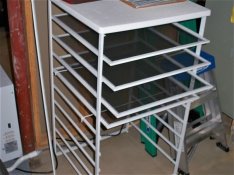I saw that a while ago and forgot about it, looks like a pretty good idea. I wish he had more pictures explaining the construction. Does the heater just blow on the top? I have a heater and plenty of mdf and cardboard so may give it a shot.
Its a really cool system and its fast and makes an excellent result. I am traveling so I can take any images but its a really easy build.
How I build it.
You can see the build as two stages, one box containing the fan ( i will call it the fan box) and a tray holding your print, blotting paper and corrugated board.
Build:
First I made the box holding the fan. Its a MUST that you can turn of the heat on the fan and only run air.
See the fan box as a box with a missing side (the side that connects to the print tray) and a hole at the top where the fan sits and blow down. Personal i mounted the fan on the top because I didnt want it too blow at the prints but I am not sure if its a must, it cant hurt having the air not hitting the prints direct.
The fan box has the same height and width as the print tray.
Next is the tray that holds your prints, it contains of a base and two sides, the width of the base is the same as the fan box and the height of the sides should be the same height as your fan box height.
This is it, now either connect your fan box with the print tray or keep them as two units.
Usage:
Usage, when I have wet prints ( I have two, one for 11x14 and my new one for 20x24) I start by completely squeegee them as dry as I dare, I don't want a single drop of water on them (it leaves spots)
At the bottom of the "print tray" I place a corrugated board of the size of the print tray with the "air holes" in the paper going in the direction of the air flow ( so they channel the air from the fan box to the front).
then I place one blotting paper ( replace them often ) and then a print, then a blotting paper, then a corrugated board, a blotting paper, a print, a blotting paper, a corrugated board.....
When you have stacked all your prints you want to dray you place a board on top. If the print tray is not filled up to the top, so there is a space at the back where air can escape then I place another MDF board at the back that close this gap.
Do not place any weights on top of your stack, if you do your prints will glue together, also do not leave wet paper in the tray without rotating them.
Now I run the heat on low heat for 3-4 min, then no heat for another 3-4 min. The air will now flow from the fan box through the air channels in the corrugated board and exit on the front of the print tray. Now you unstack your prints and replace the blotting paper with dray once and do the process over again. I do this (it takes 20-30 min max) until the prints are almost dry and then I run cold air through the system for another 20-30 min. I dont change the blotting paper ( if they not are wet but then I run some more warm air through the pack) but I do unstack the prints and re-stack them, just to make sure they dont stick to the blotting paper.
Now you prints are dry and flat

Its a very very simple build and procedure. The best feature is that your prints will be dry in 1 hour and flat. Screens works also perfect but they do need more space, and take longer time.
PM me if you have any question (or just write in the forum)
Cheers
Anders






 Standard fiberglass. Any screen maker. The vaunted and unnecessarily expensive ZVI screens are just those nothing more exotic.
Standard fiberglass. Any screen maker. The vaunted and unnecessarily expensive ZVI screens are just those nothing more exotic.